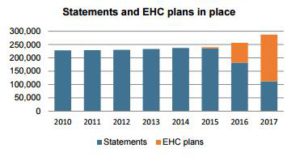Top ranked special educational needs solicitors
The Department for Education (DfE) has released its 2016-2017 statistics looking at special educational needs and disabilities (SEND) (25 May 2017). The statistics include information on the progress of transferring Statements of SEN (SSENs) and learning difficulty assessments to Education, Health and Care Plans (EHCPs) and relate to the period since the introduction of the Children and Families Act 2014 (CFA) which replaces SSENs with EHCPs.
All SSENs must be transitioned over to EHCPs by 31 March 2018. We have around two terms left for all transitions to take place. This means that, if your local authority (LA) has not already started the transition process for your child, it must do so, at the very latest, in the coming autumn term, in order that the twenty week process can be completed in good time.
The DfE statistics were collated in January 2017, around two-thirds into the timeline for full transition. They reveal how well LAs are adhering to the transition timetable and how likely it is that LAs will be ready by 31 March 2018.
In my view, the most notable key findings are:
- The number of children with a SSEN/EHCP has increased each year since 2010. The increase from January 2016 to January 2017 is 12.1% (combined total in January 2016 of 256,315 and 287,290 in January 2017).

- The age group that is increasing most significantly is the 16-19 year olds (8.9% of all CYP with an SSEN in January 2010 were 16-19 years, compared to 20.2% in January 2017). The CFA brings young people aged 20-25 years into the system for the first time. They accounted for only 2.7 of all EHCPs. I expect this figure will increase over time.
- Only 32.7% of SSENs in January 2016 were transitioned to EHCPs by January 2017. If adhering to the timeline set out in the CFA, this figure should be more like 66%.
- The number of CYP with a SSEN/EHCP attending mainstream or special school is split fairly evenly with 44.8% in mainstream school and 42.5 % in special school. Interestingly, as a direct result of the CFA, we have, for the first time, 11.5% of young people with an EHCP in further education.
- There were 14,795 initial requests for an EHC needs assessment in 2016 that were refused, an increase of 35% from 2015. This corresponds to the numbers of enquiries that we get.
- The overwhelming majority of CYP assessed are issued with an EHCP (95.6%).
- In 2016 only 55.7% of new EHCPs were issued within the 20 week lime limit. Looking at individual LAs – it looks like Dorset is in trouble, with only 1.9% of new EHCPs issued within 20 weeks. This is from a total of 268 EHCPs issued. Ten LAs have issued fewer than 10% of EHCPs within the 20 week time limit.
- The statistics states that there were 6,442 personal budgets in place in EHCPs or reviewed in 2016. It’s unclear whether these led to direct payments but I am assuming, perhaps generously, that they did lead to payments. At first glance, the relatively high figure is surprising. I have only come across a handful of agreed personal budgets. Upon closer inspection, the majority of these were for social care, with only 525 agreed for education support. I’m unsure what percentage this is but it must be a very low figure and not in line with the spirit of the CFA.
- There were 1,886 mediation cases in 2016 and, of these, 25.3% proceeded to an appeal in 2016 (this does not include those that went to appeal in 2017 following mediation in 2016). I’m not sure that we can draw any firm conclusions about the success of mediation from statistics alone. A more detailed study of what parents are hoping to achieve and reasons why they do not proceed to appeal following mediation needs to be carried out to establish its success in resolving disagreement.
- A key problem with the EHCP is the difficulty or lack of joined up working between Education, Health and Social Care. The SEND Code of Practice 2015 states that a Designated Medical Officer (DMO) or Clinical Officer (DCO) should be employed to support clinical commissioning groups in meeting its statutory responsibilities for CYP with SEND. The DMO/DCO should be the point of contact for LAs, schools and colleges seeking health advice for CYP with SEND. The DMO can support schools with their duties under ‘Supporting Pupils with Medical Conditions’ guidance and should routinely be involved in assessments and planning health support. Some clinical commissioning groups may delegate key decisions, such as agreeing the health services in an EHCP, to the DMO/DCO. Sixteen LAs did not have a DMO or DCO in place. That represents just over 10% of all LAs. That, I would say, is simply not good enough.
For all the statistics on increases/decreases of CYP with a SSEN/EHCP in individual LAs and also where apprenticeships, traineeships and supported internships are taking place, take a look at the full DfE statistics here.
I am so happy at the outcome, I don't think we would have had such a comprehensive service from any other law firm, and you took the worry away...I do not regret a single second of the whole process, apart from the bit before you got involved.
James' mother, Boyes Turner client
Contact our expert specialist education solicitors today for support with your claim

